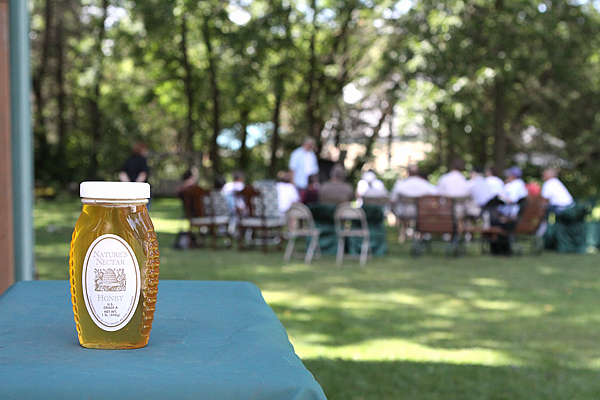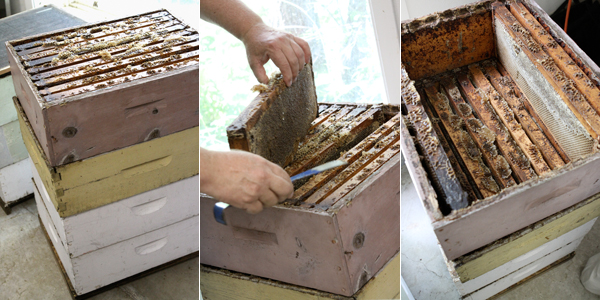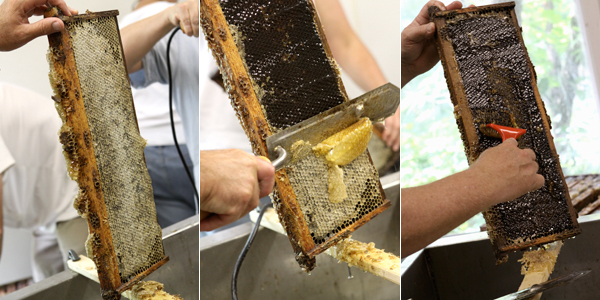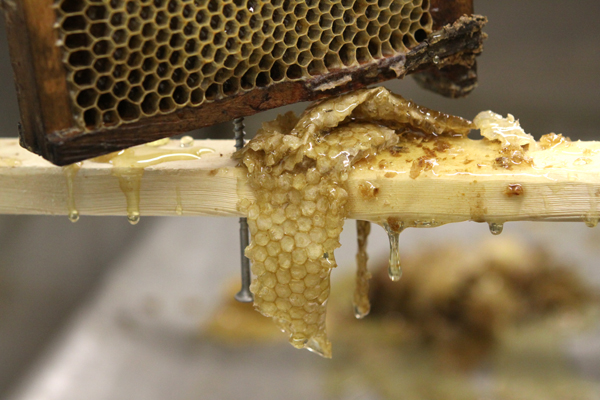
The rewards of beekeeping are sweet — golden honey that tastes like pure joy. But to get to this point, you have know a few things about bees.
The Heavy Table profiled Nature’s Nectar beekeeper Jim Kloek, providing a lesson on beekeeping 101. Time has passed and while we’ve been busy with other summer pleasures, the bees have been busy making honey. It is now time to extract.
In Minnesota, the nectar flow is “a short, intense season,” says Kloek. He starts his extraction in mid- to late August and finishes in September. Although not a complicated process, there are many tips and shortcuts that experienced beekeepers know. To pass this information along, Kloek organizes an annual extraction demonstration class for new beekeepers. The crowd of 40, ranging from aspiring beekeepers to second-year veterans, gathered on a hot Sunday to learn and participate. At the end of the session, each attendee left with a better understanding of the process, as well as a container of Nature’s Nectar honey, which we had a hand in extracting.
Kloek, along with Jerry Linser of Honey-Pine Apiary, taught the class. Linser has been keeping bees since 1978 and has won several Minnesota State Fair awards for his honey and his bees. In 1985 he won the sweepstakes for Quality Honey and Bees.
The extraction process is broken into three steps:
1. Separating the supers (boxes that contain the frames of honey)
2. Extracting the honey
3. Bottling.

1. Separating the Supers
While there are several methods for separating the bees out of the supers, including the use of a honey robber (a fluid designed to drive the bees out of the supers by sheer stink alone), Linser recommends a different way — using a bee escape.
The bee escape is essentially a one-way door designed for bees. This is fitted onto a frame that is then laid on top of the brood boxes (the bottom boxes are reserved solely for the raising of the brood by the queen). The supers are then placed on top of the bee escape and in two days, Linser estimates that about 95% of the bees will have left.
Regardless of the method you choose, there will still be a few bees left in the supers to deal with before you can get to the honey. After dressing in protective clothing and smoking the hive, remove the top supers, leaving the brood box alone (this belongs to the bees). Place an empty super on top of the brood box.
From the supers that were removed, carefully remove one frame. Holding it over the empty super, lightly shake it and brush off any remaining bees. Once free of bees, place the frame inside an empty box to the side. Repeat with all frames, covering the super containing the bee-less frames in between.
Kloek also demonstrates a simple brush-off method for removing bees from the frames in this video.

2. Extracting the Honey
There are many tools and machines that will make this process easier. In fact, some machines fully automate the process. These methods are costly and not usually an option for the hobby beekeeper. Kloek recommends using a simpler approach — a hot knife, a capping scratcher (plastic handled tool with metal scratching needles), and a hand-crank honey extractor. He uses an extractor that holds three frames, which speeds up the extracting process.
Kloek shares some pre-extracting thoughts, including safety tips, on his website. He also recommends performing this process in a closed room, to prevent bees from entering, and one that is on the warm side (about 85 degrees), as warm honey is easier to extract.

First, remove one frame from the super. Holding it vertically over a large tank or bucket (to catch the wax and overflow honey as you work), use the hot knife to slowly cut the wax using a light sawing motion, working from the top to the bottom. The heat will do the work, so use a light touch. Follow up by using the capping scratcher to remove any wax that was not cut off by the knife. There is no need to dig with the scratcher — a light scratching will do. Immediately place the uncapped frame into the extractor and move onto the next frame.
Place a bucket fitted with first a cloth filter, then a double sieve strainer under the release valve. This valve will remain closed during the extraction process to prevent any honey from flowing out into the bucket.

Once three frames (or however many frames your extractor will hold) are uncapped and fitted into the extractor, close the lid and turn the crank slowly in one direction. After a minute, stop the extractor and flip the frames from front to back. Continue cranking, at a higher speed, for another minute or two. Repeat this a few times with fresh, uncapped frames until a quantity of honey is built up inside the extractor.
When you are ready, open the release valve and allow the honey to pour into the sieve and filter below. A moisture reading using a refractometer will ensure that the honey is grade A (<18.6% moisture content). The achievable moisture content depends on the overall climate of the locale. Desert honey is generally thicker and reads around 13%, while Minnesota honey averages about 17.4%, says Kloek.

3. Bottling
Bottling can be a complicated process using automatic bottling equipment and water jackets to warm the honey. A simpler process for the hobby beekeeper is to simply pour the filtered honey into clean containers and seal. A label can be added, but nothing fancy is needed — the taste of pure honey speaks for itself.
Resources:
Nature’s Nectar — Owner and beekeeper Jim Kloek shares his beekeeping process through blog posts and videos. Kloek also rents and sells beekeeping equipment, including the hand-crank honey extractor used during the extraction class.
Olivarez Honey Bees, Inc. — California-based honey bee supplier


Just to let you know that I did indeed win the MNSF Bee and Honey award in 1985, but in addition I won that same award the last 5 consecutive years (04, 05, 06, 07 and 08). Not much hope for making it 6 years in a row as my honey crop was a bit light this year especially in the comb honey production.
Jerry – Excellent! Thank you for the clarification on the years of your awards. It certainly was a pleasure to learn from such an experienced team of beekeepers.